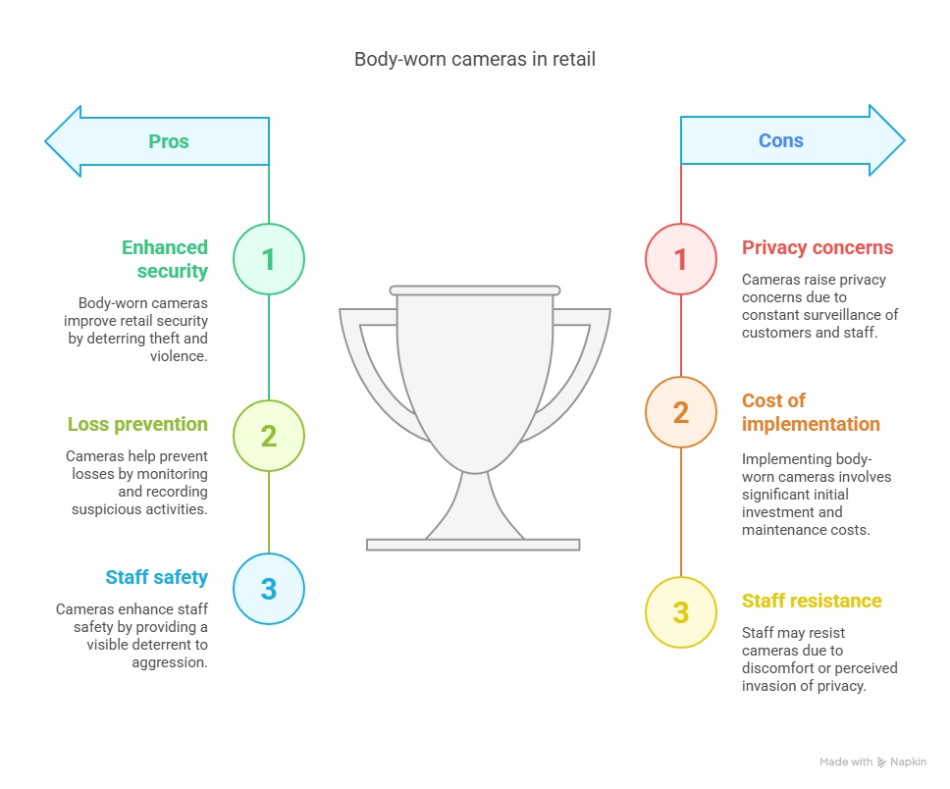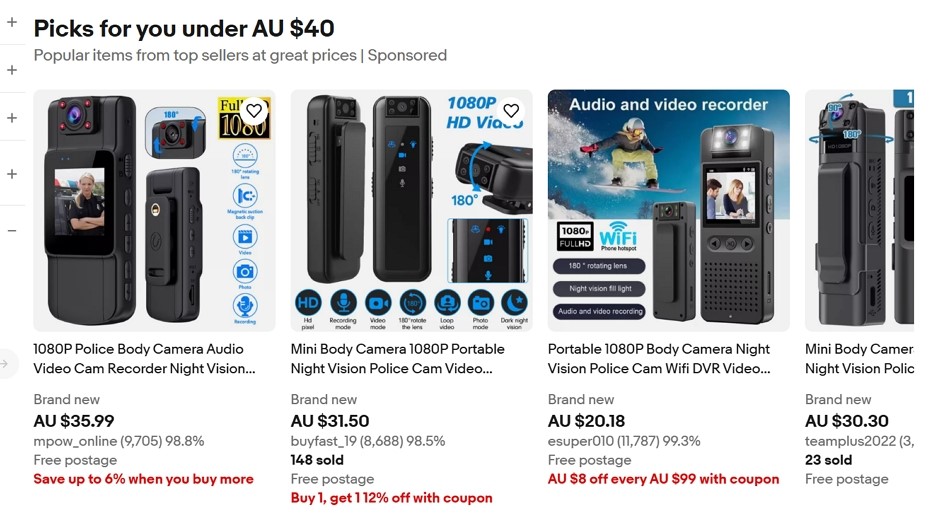
I was listening to a discussion on retail security in the UK. What stunned me was the discussion on the growing use of body-worn cameras. These are becoming standard security tools in retail there. Australian retailers will begin to explore their full potential here. These cameras present a promising solution for improving retail security, loss prevention, and staff safety.
Global Trends and Local Adoption: Where Does Australia Stand?
In a survey in the United Kingdom, 60% of retailers have adopted or reported testing these cameras. Although I have no figures for the UK, retailers have reported a 37–45% reduction in violent incidents after introducing these cameras in the United States. According to a 2024 Motorola Solutions survey in the US, more than half of global retail workers feel safer equipped with these cameras. It all sounds pretty positive.
Why I Think that Body-Worn Cameras Matter for Australian Retailers
Deterrence
The visible presence of cameras reduces and discourages aggression. For example, UK supermarkets saw a 20% drop in aggressive incidents after adopting these cameras. It creates a safer work environment.
Evidence Management
They produce a high-definition video from a staff perspective, which provides reliable evidence for resolving disputes and improving incident resolution and loss prevention outcomes.
De-escalating Conflicts
It has been found that they generate a psychological deterrent, as being recorded has led to a dramatic reduction in assaults in the UK.
Supporting Accountability
Video evidence protects staff from false accusations and customer complaint investigations.
Improving Operational Efficiency
I can see many advantages.
The faster incident resolution would streamline the investigation of discrepancies, customer complaints, and workplace incidents.
We have investigated integrating these cameras into our point-of-sale system. This promises to link your transaction data with video evidence so you can view each incident comprehensively from the staff's view.
The cameras required
After some searching, I found them selling for $30, but I would not recommend them for several reasons. Looking at them, one can see clearly that not all such cameras are equal.
I noticed in the UK talk that the retailers discussed several types, all of which were of good quality. Not surprisingly, the right choice for a body-worn camera in your retail environment can make a significant difference to staff safety, loss prevention, and operational efficiency.
I put together some critical features and practical considerations for Australian retailers that I can see.
Key Features in cameras in a Retail Setting
Video and Audio Quality
Clear footage is critical for incident review, evidence management, and staff protection. I would suggest:
- Minimum 1080p high-definition video resolution to ensure faces and actions are easily identifiable.
- A wide-angle lens to capture a broader field of view is especially useful in busy shop environments.
- High-quality microphones to record conversations accurately, supporting dispute resolution and compliance.
- Date and time stamping??? The courts want accurate, tamper-proof date and time stamps, but the problem in my experience is that time drift and daylight saving can be a real pain to use in practice. I leave this to your judgement.
Battery Life
Your staff work many long hours.
- Aim for at least 12 hours of battery life per charge to cover a full shift.
- I noticed some models had quick-swap batteries, which would give added flexibility, and I recommend.
- You need spare batteries.
Ease of Use
Since your staff is probably not a photographic expert in a shop, you need intuitive technology.
- One-touch recording ensures staff can activate the camera quickly, even under stress.
- Visual and vibration indicators confirm when recording is in progress. As it's visual, your customers know it's recording, and as it vibrates, your staff do too. This reduces uncertainty.
Discreet and wearable
- As no one likes Big Brother, you need something that intimidates customers as little as possible.
- Easy to wear with many different outfits.
- Wireless upload, so if anything happens, you have a record.
Storage Capacity
Fortunately, retail incidents are infrequent, but when they occur, you will need substantial documentation
- Look for at least 32GB internal storage or higher.
- Loop recording means you do not have to reset it continuously because the oldest footage is overwritten.
Low-light and Night Vision Capability
Shops often have poorly lit areas. Cameras with low-light or infrared capability capture critical details regardless of lighting conditions.
Durability
Retail environments are terrible environments for electronics. People drop them, dust is often around, and, as we have discovered with our other POS equipment, people love to drop coffee over the equipment.
Legal compliance
These cameras in a retail setting require more rigorous legal compliance than regular fixed cameras. This is due to their ability to record private conversations and sensitive interactions, which triggers stricter privacy, consent, and data protection requirements under Australian law. You should discuss this with someone who knows more about these things than I do. Please consult for legal advice to comply with federal and state laws, as requirements vary. In Tasmania, for example, if you are recording sound, you must notify people somehow.
I would only use cameras with encryption and allow only senior staff access to the information. Make a clear policy of deleting the information after 30–90 days unless required for an investigation; if the camera is set to loop recording, as I suggested earlier, this would happen automatically.
Return on Investment
My understanding is that this is very good.
UK retailers claim to recoup their investment within 6–8 months through lower theft rates. Interestingly, they also claimed it minimises the risk and costs of wrongful dismissal claims and workers' compensation disputes.
Future Outlook: 2025–2030
When I asked our suppliers, they told me that the security industry forecasts that Australia's market for such cameras will grow by 23% annually by 2030.
Practical Steps for Retailers Considering Body-Worn Cameras
If you are considering such cameras for your retail business, I suggest:
- Buy a cheap one and try it out. There is no point in getting an expensive one and finding it unsuitable. Cheap ones start from $40.

- Try it first and see how you go.
- Then get your staff to try it.
- Review
Further reading
Here are links that I think you will find helpful on this subject
Can cameras save our shop workers from attack?
Why retailers are turning to body-worn cameras for loss prevention.
Body-Worn Cameras for Retail and Shopping Centres
Tackling the retail crime epidemic with technology – Are body-worn cameras the answer?
Will Body Cameras Scare Shoplifters?
Bernard Zimmermann is the founding director at POS Solutions, a leading point-of-sale system company with 45 years of industry experience. He consults to various organisations, from small businesses to large retailers and government institutions. Bernard is passionate about helping companies optimise their operations through innovative POS technology and enabling seamless customer experiences through effective software solutions.
Written by:

Bernard Zimmermann is the founding director at POS Solutions, a leading point-of-sale system company with 45 years of industry experience. He consults to various organisations, from small businesses to large retailers and government institutions. Bernard is passionate about helping companies optimise their operations through innovative POS technology and enabling seamless customer experiences through effective software solutions.



